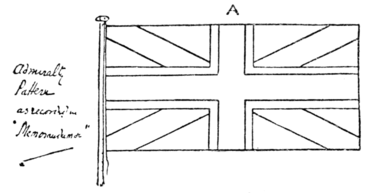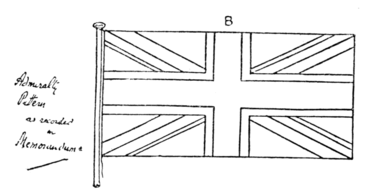In keeping with this, the general mode of procedure, the Proclamations demand our attention. The Proclamation of James (1606). A high official of the College of Arms informs us that neither verbal blazon nor drawing of the first Union Flag is extant. On the other hand, in the Proclamations of 1707 and 1801 we have both blazon and drawing. The blazon has already been given of the 1801 flag (which is the one most needing a verbal blazon), and the drawings of both flags we here produce (Figs. 776 and 777). These drawings—though slightly reduced in these pages—are most careful copies of the signed copies supplied to us by the official already alluded to. In forwarding them he writes: "They are not drawn to scale;" and he adds, further on, "they are exactly the same size as recorded in our books." So then we have, in these two drawings, the heralds' interpretation, at the time, of their own verbal blazon. Now comes the Admiralty part of the work. In the Admiralty Regulations we have a "Memorandum relative to the origin of the Union Flag in its present form." In this there is a brief history of the changes made in the flag from time to time, with quotations from the warrants, together with the verbal blazon AND two coloured drawings (Figs. 778 and 779). The Admiralty has also appended to the Memorandum the following interesting and ingeniously worked out Table of Proportions, adapted for a flag 15 feet by 7½ feet. Presumably this table forms the basis upon which all Union Flags are made up under Admiralty supervision:—
| ft. | in. | |||||||||
| The + of | St. George Two borders 1⁄15 each |
1⁄5 2⁄15 |
together 1⁄3 | 1 1 |
6 0 |
1⁄3 | ||||
| The × of | St. Patrick Its border St. Andrew |
1⁄15 1⁄30 1⁄10 |
together 1⁄10 |
0 0 0 |
6 3 9 |
1⁄5 | ||||
 Fig. 778.—Admiralty Pattern of 1707 Flag. |
 Fig. 779.—Admiralty Pattern of 1801 Flag. |
The student of heraldry will observe that this table is based on the proportions of the Ordinaries and Sub-Ordinaries figuring on the flag, as those proportions are regulated by English Rules of Armory. These rules give a cross as ⅓, a saltire as 1⁄5, a fimbriation about 1/20, of





